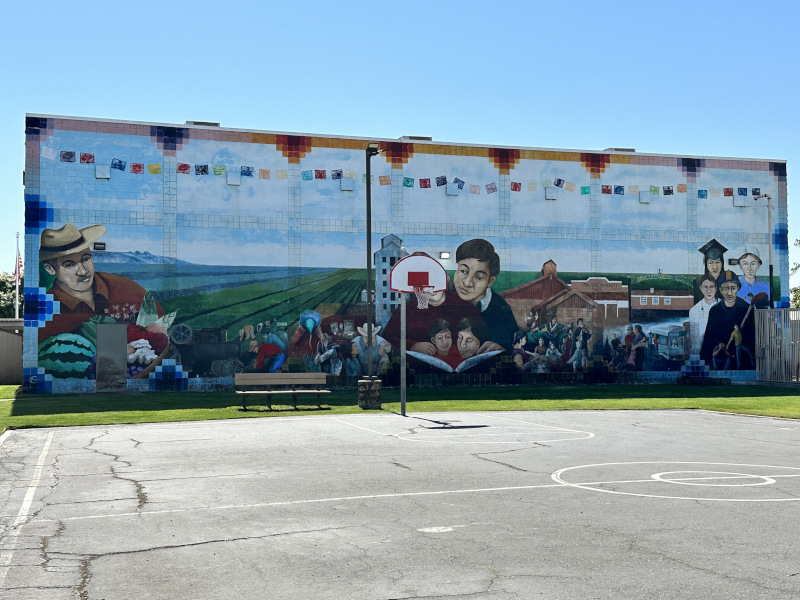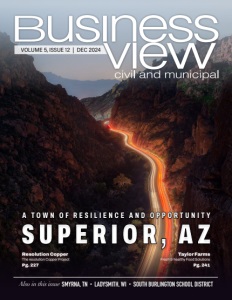San Joaquin, California
Investing in the Heart of the Valley
Where ‘everybody knows everybody’
Known once as the “Sweetheart City,” San Joaquin lies in California’s west Fresno County, a small yet resilient community infused with history and shaped by agriculture. Spanning just one square mile, San Joaquin may be the smallest of Fresno County’s 15 incorporated cities, but it has ambitious plans for its future. With a predominantly Hispanic population, multi-generational families, and deep-rooted connections, San Joaquin’s identity revolves around community. As Mayor Julia Hernandez explains, “It’s one of those small towns where everybody knows everybody. Many residents went to school here, moved away to attend college, and returned to serve their community in various capacities.”

Mayor Julia Hernandez
Despite its rural charm, San Joaquin faces distinct challenges in housing, infrastructure, and economic opportunity. In recent years, city leaders, including Mayor Hernandez and City Manager Elizabeth Cabrera, have focused on addressing these issues to pave the way for sustainable growth. With housing projects, infrastructure upgrades, and a concerted effort to partner with community organizations, San Joaquin’s leadership is determined to transform the city into a thriving, self-sufficient community for current and future generations.
Building homes and stability
One of the most urgent issues facing San Joaquin is affordable housing. Cabrera states, “Housing has been a top priority for several years. We have around 1,000 residential rooftops, with multiple generations often living under one roof. If our upcoming housing projects succeed, they could increase our housing capacity by 40%.” San Joaquin’s growing population underscores the need for additional housing, many of whom face economic constraints and limited options for affordable living spaces.
However, the path to new housing developments has been riddled with obstacles. Being a rural community about 45 minutes from the nearest urban center, the city encounters significant logistical and financial challenges. Construction costs are notably higher in San Joaquin than in nearby cities, deterring developers from undertaking projects there. Cabrera notes that “our median household income is around $45,000, making it difficult for many families to afford new homes, especially with rising interest rates. We’re working with developers to explore infrastructure investments that might offset some of these costs and make it feasible for builders to offer affordable homes.”
As Hernandez emphasizes, “Providing safe, affordable housing is about more than just physical structures; it’s about giving families a stable foundation to build their lives and achieve their dreams.” This includes families who may be undocumented or have migrated to San Joaquin seeking new opportunities. Hernandez adds, “We have an obligation to help these families find a place in our community where they can feel secure, raise their children, and thrive.”
Laying the groundwork
To support its vision for growth, San Joaquin has been upgrading its infrastructure with significant investments in water and sewer systems. Cabrera reports, “Our sewer system has undergone extensive upgrades, and our wastewater treatment plant now can support a community twice our size.” However, water quality remains a critical concern. Manganese in the water has led to discoloration, with water sometimes appearing tea-like. This issue affects residents’ daily activities, from washing clothes to cooking.
 “Manganese in the water may seem like a small inconvenience, but it disrupts basic day-to-day tasks,” Cabrera says. Since 2015, the city has sought funding to address this challenge, and in 2024, their efforts bore fruit: a $30 million grant was secured to tackle water quality issues. These funds will be used to build new treatment plants, install additional water lines, and ensure clean, safe water is available for all residents. “Once complete, we’ll finally be able to provide clear water for everyone,” Cabrera adds. “This will be foundational for our community’s health and quality of life, as well as for the new housing and businesses we hope to attract.”
“Manganese in the water may seem like a small inconvenience, but it disrupts basic day-to-day tasks,” Cabrera says. Since 2015, the city has sought funding to address this challenge, and in 2024, their efforts bore fruit: a $30 million grant was secured to tackle water quality issues. These funds will be used to build new treatment plants, install additional water lines, and ensure clean, safe water is available for all residents. “Once complete, we’ll finally be able to provide clear water for everyone,” Cabrera adds. “This will be foundational for our community’s health and quality of life, as well as for the new housing and businesses we hope to attract.”
Road maintenance presents another hurdle. With a small population, San Joaquin’s state and federal funding allocations are limited, often insufficient for the extensive repairs the city’s roads require. “With more housing developments on the horizon, we’ll need to prioritize roadwork to support this growth,” Cabrera explains. “It’s an ongoing challenge, but one we’re committed to addressing as we continue expanding our community.”
Transportation innovation
Transportation in San Joaquin is another concern, especially given the city’s remote location. “We’ve partnered with Fresno Council of Governments to introduce a micro-transit program, an ‘Uber-like’ service that will use electric vehicles,” Hernandez explains. This program, expected to launch next year, aims to provide affordable, convenient transportation options for residents without limited mobility. With fares around $5 per one-way trip and reduced rates for seniors, this program is designed to ease transportation costs and logistical challenges for those traveling to larger cities or attending appointments.
Unlike traditional public transit, this service will allow drivers to wait with residents at their destinations, addressing accessibility concerns for seniors and those with mobility issues. “We’re excited about this program, primarily because it directly meets the needs of our community,” Hernandez says. “Having a resident as the driver and keeping the vehicle stationed in San Joaquin will reduce costs and ensure a more tailored service for our residents.”
This program, which starts with one electric vehicle, reflects the city’s commitment to sustainability and innovation. “We’re beginning with a single electric vehicle, but if the demand grows, we’re prepared to expand the program,” Hernandez explains. Charging stations, security measures, and other infrastructure improvements will accompany this initiative, positioning San Joaquin as a model for rural transportation innovation.
Agriculture in transition
Agriculture remains San Joaquin’s primary industry, providing employment and shaping the city’s economy. Sal Parra, Jr., Director of Farming at Burford Ranch, describes the impact of drought and water scarcity on local farms: “Due to water shortages, we’ve seen a shift to permanent crops like almonds, pistachios, and grapes, which require less labor due to increased mechanization.”
This shift, while helping farms adapt to water limitations, has reduced job opportunities in agriculture. To mitigate these changes, farms in the area are incorporating advanced technologies to maximize productivity and resource efficiency. “Farmers are using new technology, such as irrigation sensors, to monitor and optimize water usage,” Parra says. “We’re also seeing the introduction of robotics and automation, which decreases the reliance on manual labor.” However, he adds, “This raises a need for local manufacturing facilities and other businesses that could offer jobs to residents displaced by automation in traditional agriculture roles.”
Parra highlights the resilience of the agriculture sector, stating, “Our community is very much ag-dependent. With innovations and shifts in the sector, we’re hopeful that ag-related industries, especially those in manufacturing and processing, will consider setting up operations here to help support our local economy.”
Community first
A feature of San Joaquin’s approach to community development is its partnerships with local organizations, including the Salvation Army. The Salvation Army has served the city since 2013, bringing essential resources and services to residents. Mark Ford, a Salvation Army Golden State Division representative, explains, “We provide around 1,500 meals per month through our weekly hot meal program, plus a USDA commodities distribution that feeds about 150 families.”
Ford emphasizes the importance of local partnerships, particularly in a small community like San Joaquin. “The city has been instrumental in helping us expand our reach. Their support in funding food costs has allowed us to serve more residents, which is critical given the high need in this area,” Ford says. In addition to meal programs, the Salvation Army operates a “Fresh Rescue” initiative twice weekly, collecting produce and meat donations to distribute to residents.
Ford also mentions seasonal programs like holiday meals, which draw up to 800 people, and emergency food boxes for families in need. “We’re thrilled to be in San Joaquin,” he says. “The city’s partnership allows us to meet the community’s physical and emotional needs.”
Hernandez recognizes the vital role of these partnerships: “Organizations like the Salvation Army are critical to ensuring that our families have what they need to be successful now and in the future. They help create a support network that’s essential to the well-being of our residents.”

A five-year plan for progress
San Joaquin’s leadership has a clear set of priorities for the next five years. Water quality and affordable housing are top concerns, with significant resources dedicated to addressing both. “As we secure funding and break ground on new treatment plants, our residents will finally have access to clean, reliable water,” Hernandez says. “This is priority number one.”
Affordable housing, too, remains essential. The city recently added 19 new homes, the first in decades, but demand continues to grow. “We know there’s a need, but we have to ensure these homes are obtainable for our residents,” Hernandez explains. “Our goal is to provide families a place to feel rooted, raise their children, and build a future.”
AT A GLANCE
San Joaquin, California
What: A small, close-knit community surrounded by vast farmland and deeply rooted in agricultural traditions.
Where: Located in west Fresno County, California.
Website: https://cityofsanjoaquin.org/



